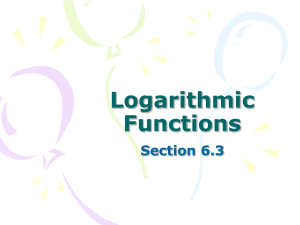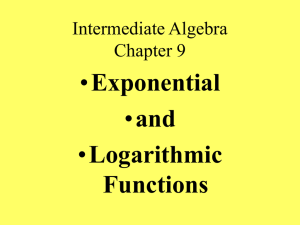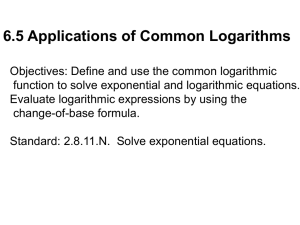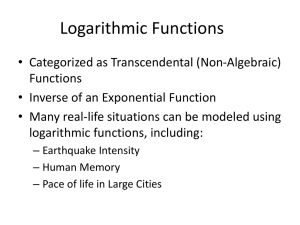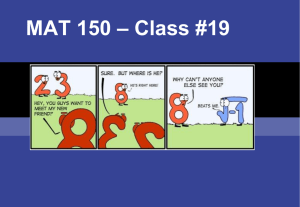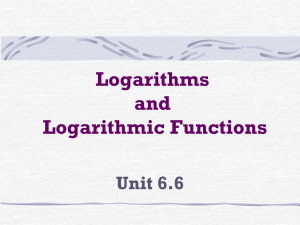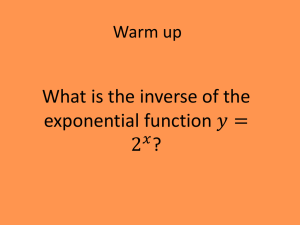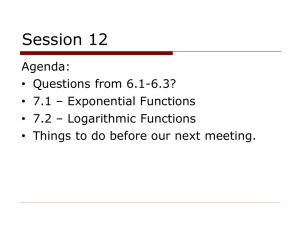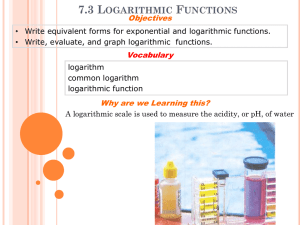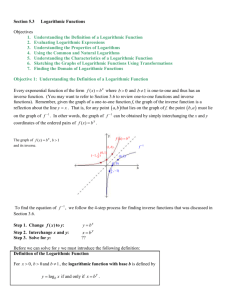Chapter 5 PowerPoint
advertisement
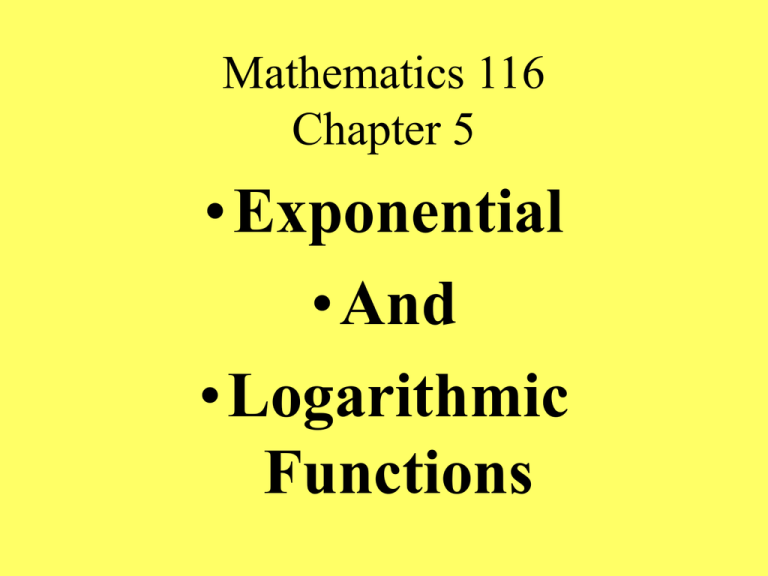
Mathematics 116
Chapter 5
• Exponential
•And
• Logarithmic
Functions
John Quincy Adams
• “Patience and perseverance
have a magical effect before
which difficulties disappear and
obstacles vanish.”
• Mathematics 116
• Exponential Functions
• and
Def: Relation
• A relation is a set of ordered pairs.
• Designated by:
•
•
•
•
•
•
Listing
Graphs
Tables
Algebraic equation
Picture
Sentence
Def: Function
• A function is a set of ordered pairs in
which no two different ordered pairs
have the same first component.
• Vertical line test – used to determine
whether a graph represents a function.
Defs: domain and range
• Domain: The set of first
components of a relation.
• Range: The set of second
components of a relation
Examples of Relations:
1, 2 , 3, 4 5, 6
1,2 , 3,2 , 5,2
1,2 , 1,4 , 1,6
Objectives
• Determine the domain, range of
relations.
• Determine if relation is a
function.
Mathematics 116
•Inverse Functions
Objectives:
• Determine the inverse of a function whose
ordered pairs are listed.
• Determine if a function is one to one.
Inverse Function
• g is the inverse of f if the domains and
ranges are interchanged.
• f = {(1,2),(3,4), (5,6)}
• g= {(2,1), (4,3),(6,5)}
1
g ( x) f ( x)
Inverse of a function
f 1,2 , 3,4 , 5,6
f
1
2,1 4,3 , 6,5
Inverse of function
f 1,2 , 3,2 , 5,2
f
1
2,1 , 2,3 , 2,5
One-to-One Function
• A function f is one-to one if for and and b in
its domain, f(a) = f(b) implies a = b.
• Other – each component of the range is
unique.
One-to-One function
• Def: A function is a one-to-one
function if no two different
ordered pairs have the same
second coordinate.
Horizontal Line Test
A test for one-to one
• If a horizontal line intersects the
graph of the function in more
than one point, the function is
not one-to one
Existence of an Inverse Function
• A function f has an inverse
function if and only if f is one
to one.
Find an Inverse Function
• 1. Determine if f has an inverse function
using horizontal line test.
• 2. Replace f(x) with y
• 3. Interchange x and y
• 4. Solve for y
1
• 5. Replace y with
f ( x)
Definition of Inverse Function
• Let f and g be two functions such that
f(g(x))=x for every x in the domain of g
and g(f(x))=x for every x in the domain
of.
• g is the inverse function of the function f
Objective
• Recognize and evaluate
exponential functions
with base b.
Michael Crichton – The Andromeda Strain
(1971)
• The mathematics of uncontrolled
growth are frightening. A single cell of
the bacterium E. coli would, under
ideal circumstances, divide every
twenty minutes. It this way it can be
shown that in a single day, one cell of
E. coli could produce a super-colony
equal in size and weight to the entire
planet Earth.”
Graph
• Determine: Domain, range, function and
why, 1-1 function and why, y intercept, x
intercept, asymptotes
f ( x) 2
x
Graph
• Determine: Domain, range, function and
why, 1-1 function and why, y intercept, x
intercept, asymptotes
1
f ( x)
2
x
Exponential functions
• Exponential growth
f ( x) b , b 1
x
• Exponential decay
f ( x) b ,0 b 1
x
Properties of graphs of
exponential functions
•
•
•
•
•
Function and 1 to 1
y intercept is (0,1) and no x intercept(s)
Domain is all real numbers
Range is {y|y>0}
Graph approaches but does not touch x
axis – x axis is asymptote
• Growth or decay determined by base
The Natural Base e
e 2.718281828
The natural base e
1
lim 1
n
n
as n
Calculator Keys
• Second function of divide
• Second function of LN (left
side)
e
x
Dwight Eisenhower – American
President
•“Pessimism never
won any battle.”
Property of equivalent exponents
• For b>0 and b not equal to 1
if
b b
x
y
then x y
Compound Interest
•
•
•
•
A = Amount
P = Principal
r = annual interest rate in decimal form
t= number of years
r
A P 1
n
nt
Continuous Compounding
•
•
•
•
A = Amount
P = Principal
r = rate in decimal form
t = number of years
A Pe
rt
Compound interest problem
• Find the accumulated amount in an account
if $5,000 is deposited at 6% compounded
quarterly for 10 years.
.06
A 5000 1
4
4 10
A $9070.09
Objectives
• Recognize and evaluate exponential
functions with base b
• Graph exponential functions
• Recognize, evaluate, and graph exponential
functions with base e.
• Use exponential functions to model and
solve real-life problems.
Albert Einstein – early 20th
century physicist
• “Everything should be
made as simple as
possible, but not simpler.”
Mathematics 116 – 4.2
• Logarithmic Functions
• and
• Their Graphs
Definition of Logarithm
logb x y x b
y
Objectives
• Recognize and evaluate
logarithmic function with base b
• Note: this includes base 10 and
base e
• Graph logarithmic functions
–By Hand
–By Calculator
Shape of logarithmic graphs
• For b > 1, the graph rises from
left to right.
• For 0 < b < 1, the graphs falls
from left to right.
Properties of Logarithmic Function
•
•
•
•
•
Domain:{x|x>0}
Range: all real numbers
x intercept: (1,0)
No y intercept
Approaches y axis as vertical
asymptote
• Base determines shape.
Evaluate Logs on calculator
• Common Logs – base of 10
log10 x log x
• Natural logs – base of e
log e x ln x
Basic Properties of logs
log b 1 0 1 b
0
log b b 1 b b
1
log b b x
x
**Property of Logarithms
• One to One Property
If logb x logb y
then x y
Objective
• Use logarithmic functions to
model and solve real-life
problems.
Jim Rohn
• “You must take personal
responsibility. You cannot
change the circumstances, the
seasons, or the wind, but you
can change yourself. That is
something you have charge of.”
Mathematics 116 – 4.3
• Properties
•of
•Logarithms
Change of Base Formula
logb x
log a x
logb a
Problem: change of base
log 3 5
log10 5 log5
log10 3 log3
log e 5 ln 5 1.46
log e 3 ln 3
Logarithm Theorems
log b xy log b x log b y
x
log b log b x log b y
y
r
log b x r log b x
Basic Properties of logarithms
log b 1 0
log b b 1
log b x log b y x y
For x>0, y>0, b>0 and b not 1
Product rule of Logarithms
logb xy logb x logb y
For x>0, y>0, b>0 and b not 1
Quotient rule for Logarithms
x
log b log b x log b y
y
For x>0, y>0, b>0 and b not 1
Power rule for Logarithms
logb x r logb x
r
Objectives:
• Use properties of logarithms to evaluate or
rewrite logarithmic expressions
• Use properties of logarithms to expand
logarithmic expressions
• Use properties of logarithms to condense
logarithmic expressions.
Albert Einstein
• “The important thing is not
to stop questioning.”
Mathematics 116
• Solving
• Exponential
• and
• Logarithmic Equations
Solving Exponential Equations
• 1. *** Rewrite equation so exponential
term is isolated.
• 2. Rewrite in logarithmic form
• Use base ln if base is e.
• 3. Solve the equation
• 4. Check the results
– Graphically or algebraically
Exponential equation
2 x1
25
15
x 0.0794
Solve Logarithmic Equations
• 1. *** Rewrite equation so logarithmic
term is isolated. Or use one-one property
• 2. Rewrite in exponential form
• 3. Solve the equation
• 4. Check the results
– Graphically or algebraically
Sample Problem Logarithmic equation
log3 2 x 5 2
x2
Sample Problem Logarithmic equation
log 2 5 x 1 log 2 x 1 3
x3
Sample Problem Logarithmic equation
log 2 x 2 log 2 x 3
x 4 or x 2
2
Sample Problem Logarithmic equation
log5 x log5 x 3 log5 4
1
Walt Disney
• “Disneyland will never be
completed. It will
continue to grow as long
as there is imagination
left in the world.”
Objectives:
• Solve exponential equations
• Solve logarithmic equations
• Use exponential and
logarithmic equations to model
and solve real-life problems.
Hans Hofmann – early 20th century
teacher and painter
• “The ability to simplify
means to eliminate the
unnecessary so that the
necessary may speak.”
Mathematics 116
• Exponential
• and
• Logarithmic
• Models
Objective
• Recognize the most common
types of models involving
exponential or logarithmic
functions
Models
• Exponential growth
• Exponential decay
• Logarithmic
–Common logs
–Natural logs
Gaussian Model
• “normal curve”
y ae
xb / c
2
Logistic Growth Model
a
y
rx
1 be
pH
a measure of the hydrogen ion
concentration of a solution.
pH log10 H
Magnitude of Earthquake
• Uses Richter scale I is intensity which is a
measure of the wave energy of an
earthquake
I
R log10
I0
I0 1
Carl Zuckmeyer
• “One-half of life is luck; the
other half is discipline – and
that’s the important half, for
without discipline you
wouldn’t know what t do
with luck.”
Mathematics 116 – 4.6
• Exploring Data:
• Nonlinear Models
Objectives
• Classify Scatter Plots
• Use scatter plots and a graphing calculator
to find models for data and choose a model
that best fits a set of data.
• Use a graphing utility to find models to fit
data.
• Make predictions from models.
Calculator regression models
•
•
•
•
•
•
•
•
•
Linear(mx+b) (preferred) and (b+mx)
Quadratic – 2nd degree
Cubic – 3rd degree
Quartic – 4th degree
Ln (natural logarithmic logarithm)
Exponential
Power
Logistic
Sin – (trigonometric)
Julie Andrews
• “Perseverance is failing
19 times and
th
succeeding the 20 .”
Walt Disney
• “Disneyland will never be
completed. It will
continue to grow as long
as there is imagination
left in the world.”

